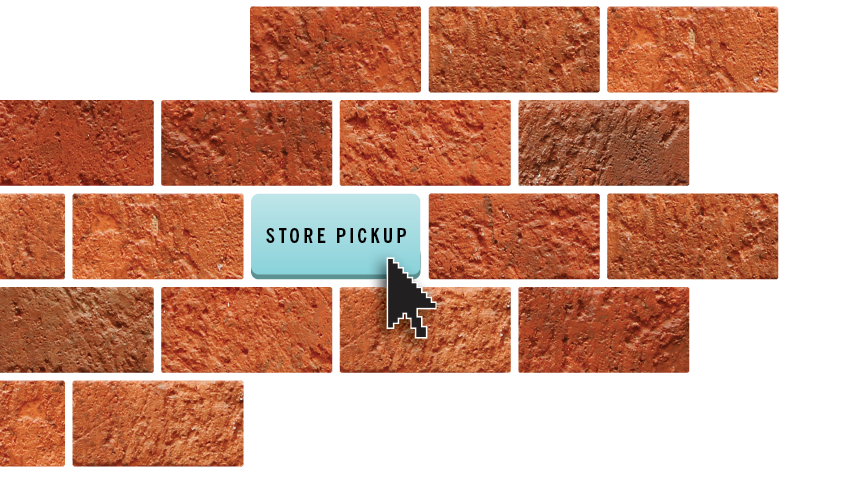How often do you really think about the different ways you can purchase an item? Imagine buying a gallon of milk. Traditionally, you would drive to the grocery store or your local market, pick up the product, check out, and head home with your purchase.
This is how it’s been done for a long time in a traditional brick-and-mortar setting.
Now, think about buying something as simple as a gallon of milk—not at the store, but through different channels. You could click a smartphone app, select your choice, complete the purchase on your phone, and your milk is delivered within two hours. Or you might prefer to do curbside pickup—or even have a weekly subscription.
Yes, the milkman still exists—in a way.
Now more than ever, retail is becoming as fluid as that milk. Competing businesses are tasked with creating new ways to better serve their customers based on many different factors. And while this is a challenge for businesses, you as the consumer are presented with a similar question: “What kind of experience do I want?”
The topic of the future of retail is interesting. What will this look like going forward? We have seen major big-box retailers closing their doors, making it is easy to picture a digital future where all of our purchases are made online.
Brick and mortar as we know it is a façade hanging out in the middle of nowhere, like a Prada store in Marfa, Texas. Consumers love getting packages delivered to their doors. But they also love the atmosphere of the shopping experience.
Consumers can have the best of both worlds. In return, companies can tailor the experience to the customer while keeping back-end costs down.
“Wait,” you may be saying to yourself. “In a world where I can purchase nearly everything online, I might still enjoy the in-store/preferred customer experience—all while maintaining company efficiency? How?”

Click and Mortar
Click and mortar is an e-commerce business model that integrates online and offline customer channels and business operations. This strategy—seamlessly connecting all channels, from the end-user interface to back-end connectivity—is known as omnichannel. Customers can shop over the internet on a retailer’s website, and still shop at the retailer’s brick-and-mortar shop.
The business model is efficient for customers when goods purchased online are shipped quickly, or when they can engage in face-to-face interactions with the retailer if they choose. Either allows the company to create an excellent customer experience.
As organizations such as Amazon influence consumer expectations, companies want to develop an experience that matches those ever-higher expectations so they can attract more consumers, while maintaining an aspect of building brand loyalty. The ability to provide consumers with a seamless and memorable experience has never been more important.
For companies, there are many benefits to adopting this click-and-mortar model. They want customers to engage with the company conveniently, in ways that match their preference. Customer preference is key here, because customers who buy these products sometimes want to physically feel the products before they will purchase online.
Generally, not all customers want to complete a purchase online, but they might start their research online. So, it’s important that the various channels support every interaction and have consistent branding and information. Providing these options can aid growth; 63 percent of customers would shop more if a company offered their preferred shopping method (Fierce Retail).
Let’s explore the benefits of an omnichannel click-and-mortar experience, for both the consumer and the business:
1. Lower Costs
Companies that run a click-and-mortar strategy reduce internal and external inefficiencies such as labor and inventory costs.
- Automation helps lower cost.
- Leveraging data from online activity can give stores insight to maintain the right inventory at the right time, creating efficiency and lowering cost.
- Example: A European telecommunications company saw a 40 percent increase in usage of its online service channel, which reduced costs by more than 20 percent, while increasing customer satisfaction by more than 5 percentage points.
2. Improve customer trust and loyalty
Customers can build a relationship with a brand knowing it has a storefront and they can interact with an employee.
- Customers gain trust that the products are high quality when they can touch and feel the merchandise before buying.
- Customers can go inside a store to see the product, to learn more about it and to experience its quality. An in-store experience helps build trust more than an exclusively e-commerce experience because humans can build more trust than a robot.
- An omnichannel strategy creates transparency for the product, the quality, and the brand promise.
- You’re not forcing one channel on them, but providing choices so they can pick what they prefer.
- According to a study by Forrester, digital touchpoints affect approximately 49 percent of total U.S. retail sales, even though only 11.6 percent of U.S. retail sales were online.1
- Meeting customers where they want to be and providing them an easy, consistent experience can help build loyalty.
- 30 percent higher lifetime customer values are attributed to consumers shopping across multiple channels.2
- Companies with omnichannel retail strategies retain an average of 89 percent of their customers from channel to channel.
3. Personalized value add
Omnichannel provides companies many sources of data, which allows them access to customer information so they can track customer buying habits. That lets them plan and forecast better, understand their customers better, and provide personalized marketing campaigns—which drive loyalty and advocacy.
- Using customer data can identify customer personas, allowing companies to send targeted, personalized offers and discounts.
- Using analytics enables loyalty programs, logistics integration, data and technology integration, and buying guides (e.g., interactive catalogs) that help consumers make purchasing decisions.
- 84 percent of marketers use customer data to inform their marketing.
- 54 percent of customers want loyalty program information automatically tied to their credit cards.
- More customers are willing to share personal data in exchange for a benefit.
How do your channel interfaces enable transparency and seamless movement across experiences for the customer? Do your operations support automation for efficiency gain?
Why do omnichannel?
To be truly omni-centric, you must address similar questions to ensure that all business functions across the front, middle, and back offices are integrated in order to provide a seamless customer experience.
Consider the front office. Functions such as marketing, sales, and customer service directly touch your customers. They must have the right tools and information to deliver that seamless experience.
The middle office must ensure that the correct information is easily and quickly accessible to those front-line defenders. It goes beyond just IT, but for an easy example, the IT team needs to make sure everything is connected and flowing across groups properly so the right information is captured.
This includes the back office. That team, and their systems, also must receive accurate information so the front office is pulling up-to-date information and so customers using your company’s systems have real-time information.
The click-and-mortar example benefits both consumers and the business. It delivers a seamless experience. Your teams must be enabled to work together to deliver a great customer experience because customers don’t care. They don’t care how the teams are working. They don’t care what tools they’re using.
They care only whether their interaction is easy and whether they have a choice about how to interact. The customer shouldn’t see any difference. It shouldn’t matter where the customer begins their shopping experience. Because to them, you’re one company, one experience.

Sources
- Retail Info System, “New Report Says Digital Touchpoints Impacted Almost Half of U.S. Retail Sales,” https://risnews.com/new-report-says-digital-touchpoints-impacted-almost-half-us-retail-sales
- Think with Google, “Omnichannel shoppers: An emerging retail reality,”https://www.thinkwithgoogle.com/marketing-resources/omnichannel/omni-channel-shoppers-an-emerging-retail-reality/
